height MAZDA MODEL CX-5 2016 (in English) User Guide
[x] Cancel search | Manufacturer: MAZDA, Model Year: 2016, Model line: MODEL CX-5, Model: MAZDA MODEL CX-5 2016Pages: 626, PDF Size: 13.81 MB
Page 270 of 626

Black plate (270,1)
NOTElIn the following cases, the Forward Sensing Camera (FSC) cannot detect target objects correctly,
and each system may be unable to operate normally.
lThe height of the vehicle ahead is low.lYou drive your vehicle at the same speed as the vehicle ahead.lHeadlights are not turned on during the night or when going through a tunnel.lIn the following cases, the Forward Sensing Camera (FSC) may not be able to detect target
objects correctly.
lWhen driving next to walls with no patterning (including fences and longitudinally striped
walls).
lThe taillights of the vehicle ahead are turned off.lA vehicle is outside the illumination range of the headlights.lThe vehicle is making a sharp curve, or ascending or descending a steep slope.lEntering or exiting a tunnel.lHeavy luggage is loaded causing the vehicle to tilt.lStrong light is shone at the front of the vehicle (back light or high-beam light from on-coming
vehicles).
lThere are many light emitters on the vehicle ahead.lWhen the vehicle ahead is not equipped with taillights or the taillights are turned off at
nighttime.
lThe vehicle ahead has a special shape.
4-136
When Driving
i-ACTIVSENSE
CX-5_8DV2-EA-14K_Edition3 Page270
Thursday, February 26 2015 5:33 PM
Form No.8DV2-EA-14K
Page 273 of 626

Black plate (273,1)
NOTElUnder the following conditions, the radar sensor (front) may not be able to detect vehicles ahead
or obstructions correctly and each system may not operate normally.
lThe rear surface of a vehicle ahead does not reflect radio waves effectively, such as an
unloaded trailer or an automobile with a loading platform covered by a soft top, vehicles with
a hard plastic tailgate, and round-shaped vehicles.
lVehicles ahead with low vehicle height and thus less area for reflecting radio waves.lVisibility is reduced due to a vehicle ahead casting off water, snow, or sand from its tires and
onto your windshield.
lThe trunk/luggage compartment is loaded with heavy objects or the rear passenger seats are
occupied.
lIce, snow, or soiling is on the front surface of the front emblem.lDuring inclement weather such as rain, snow, or sand storms.lWhen driving near facilities or objects emitting strong radio waves.lUnder the following conditions, the radar sensor (front) may not be able to detect vehicles ahead
or obstructions.
lThe beginning and end of a curve.lRoads with continuous curves.lNarrow lane roads due to road construction or lane closures.lThe vehicle ahead enters the radar sensor's blind spot.lThe vehicle ahead is running abnormally due to accident or vehicle damage.lRoads with repeated up and down slopeslDriving on poor roads or unpaved roads.lThe distance between your vehicle and the vehicle ahead is extremely short.lA vehicle suddenly comes close such as by cutting into the lane.lTo prevent incorrect operation of the system, use tires of the same specified size, manufacturer,
brand, and tread pattern on all four wheels. In addition, do not use tires with significantly
different wear patterns or tire pressures on the same vehicle (Including the temporary spare tire).
lIf the battery power is weak, the system may not operate correctly.lWhen driving on roads with little traffic and few vehicles ahead or obstructions for the radar
sensor (front) to detect,“Radar blocked”may be temporarily displayed, however, this does not
indicate a problem.
When Driving
i-ACTIVSENSE
4-139
CX-5_8DV2-EA-14K_Edition3 Page273
Thursday, February 26 2015 5:33 PM
Form No.8DV2-EA-14K
Page 277 of 626

Black plate (277,1)
NOTElThe detection ability of the radar sensors (rear) has limitations. In the following cases, the
detection ability may lower and the system may not operate normally.
lThe rear bumper near the radar sensors (rear) has become deformed.lSnow, ice or mud adheres to the radar sensors (rear) on the rear bumper.lUnder bad weather conditions such as rain, snow and fog.lUnder the following conditions, the radar sensors (rear) cannot detect target objects or it may be
difficult to detect them.
lStationary objects on a road or a road side such as small, two-wheeled vehicles, bicycles,
pedestrians, animals, and shopping carts.
lVehicle shapes which do not reflect radar waves well such as empty trailers with a low vehicle
height and sports cars.
lVehicles are shipped with the direction of the radar sensors (rear) adjusted for each vehicle to a
loaded vehicle condition so that the radar sensors (rear) detect approaching vehicles correctly. If
the direction of the radar sensors (rear) has deviated for some reason, have the vehicle inspected
at an Authorized Mazda Dealer.
lFor repairs or replacement of the radar sensors (rear), or bumper repairs, paintwork, and
replacement near the radar sensors, consult an Authorized Mazda Dealer.
lTurn off the system while pulling a trailer or while an accessory such as a bicycle carrier is
installed to the rear of the vehicle. Otherwise, the radio waves emitted by the radar will be
blocked causing the system to not operate normally.
lThe radar sensors are regulated by the relevant radio wave laws of the country in which the
vehicle is driven. If the vehicle is driven abroad, authorization from the country in which the
vehicle is driven may be required.
When Driving
i-ACTIVSENSE
4-143
CX-5_8DV2-EA-14K_Edition3 Page277
Thursday, February 26 2015 5:33 PM
Form No.8DV2-EA-14K
Page 428 of 626
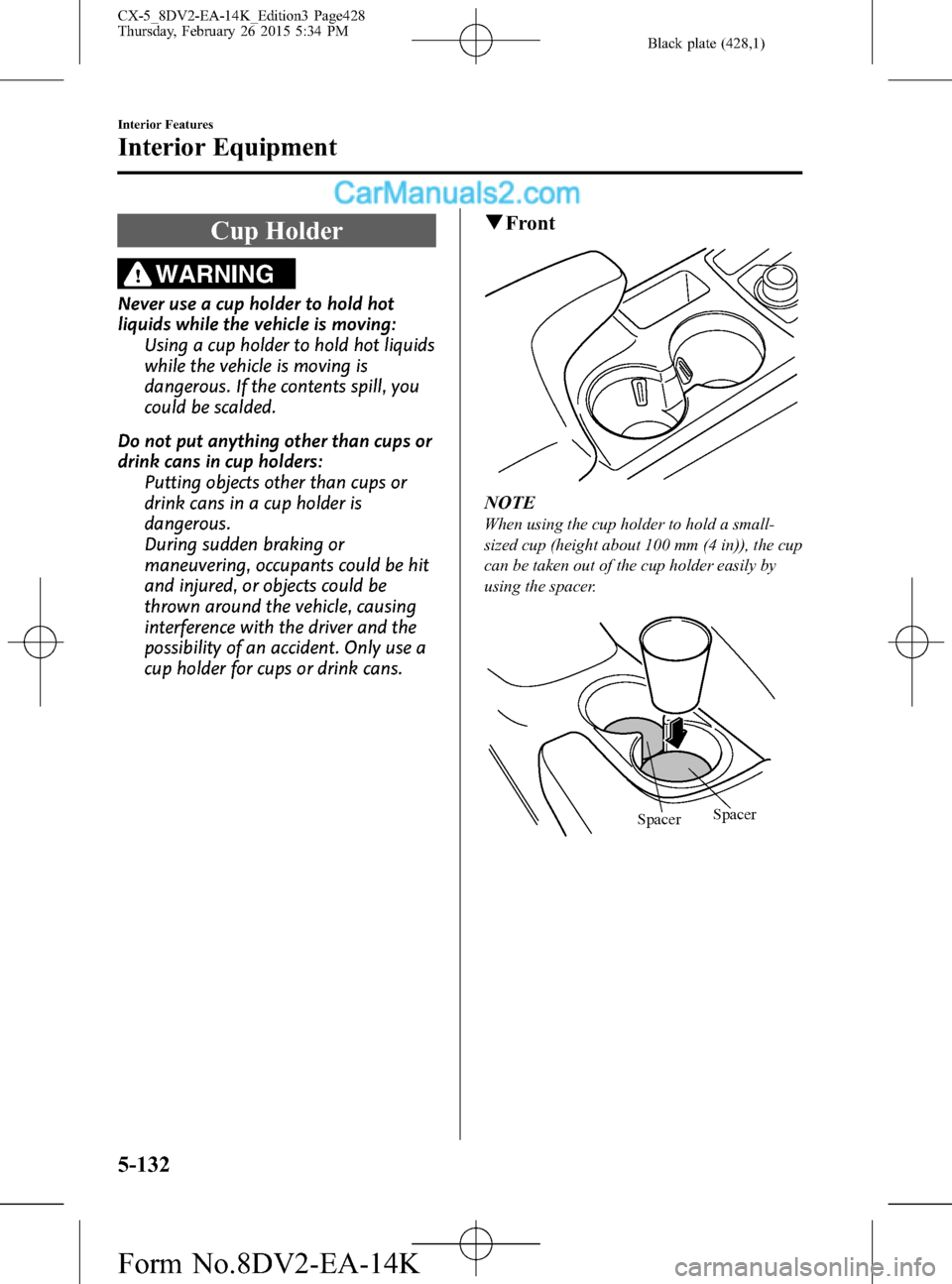
Black plate (428,1)
Cup Holder
WARNING
Never use a cup holder to hold hot
liquids while the vehicle is moving:
Using a cup holder to hold hot liquids
while the vehicle is moving is
dangerous. If the contents spill, you
could be scalded.
Do not put anything other than cups or
drink cans in cup holders:
Putting objects other than cups or
drink cans in a cup holder is
dangerous.
During sudden braking or
maneuvering, occupants could be hit
and injured, or objects could be
thrown around the vehicle, causing
interference with the driver and the
possibility of an accident. Only use a
cup holder for cups or drink cans.
qFront
NOTE
When using the cup holder to hold a small-
sized cup (height about 100 mm (4 in)), the cup
can be taken out of the cup holder easily by
using the spacer.
SpacerSpacer
5-132
Interior Features
Interior Equipment
CX-5_8DV2-EA-14K_Edition3 Page428
Thursday, February 26 2015 5:34 PM
Form No.8DV2-EA-14K
Page 457 of 626
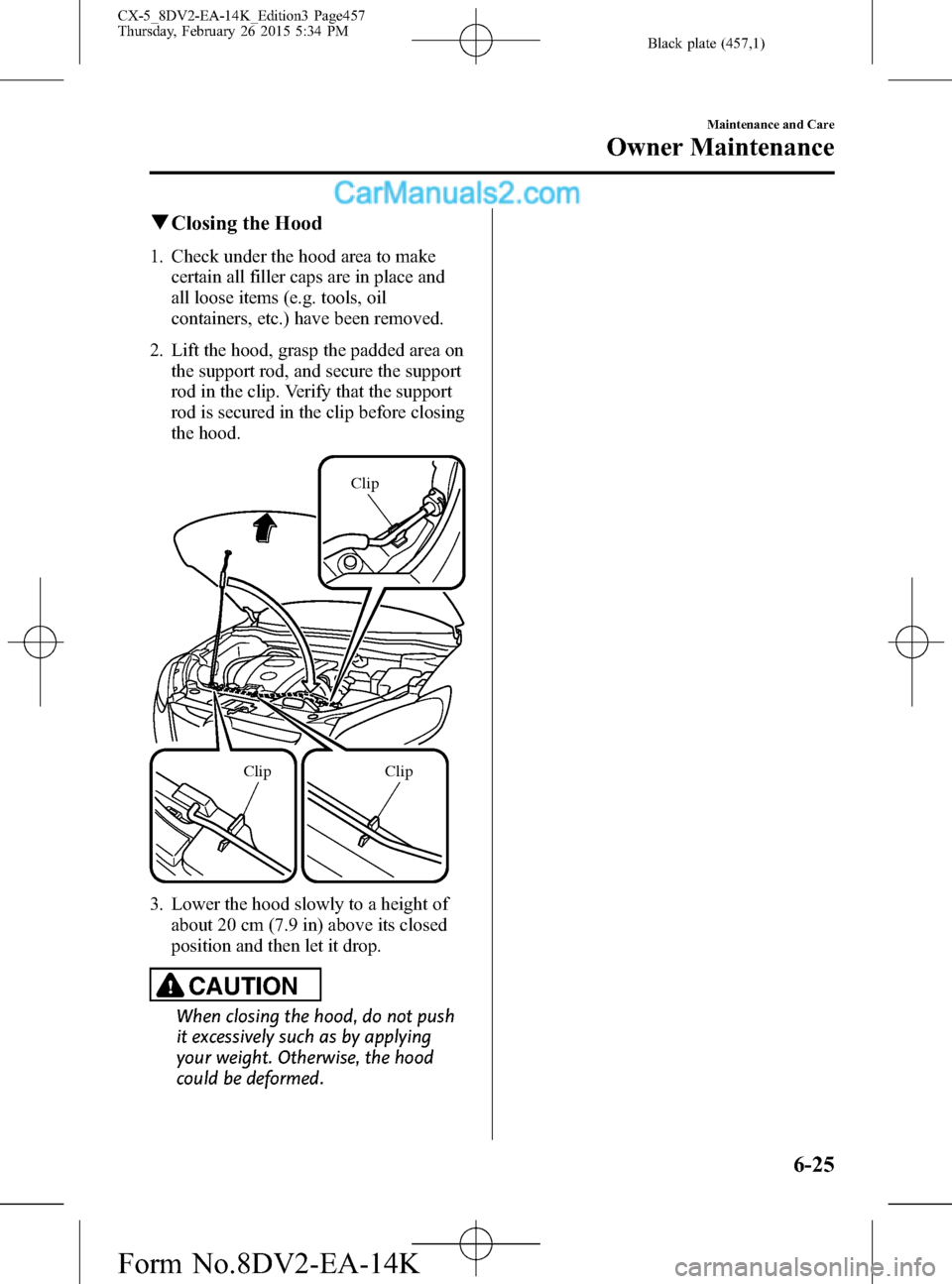
Black plate (457,1)
qClosing the Hood
1. Check under the hood area to make
certain all filler caps are in place and
all loose items (e.g. tools, oil
containers, etc.) have been removed.
2. Lift the hood, grasp the padded area on
the support rod, and secure the support
rod in the clip. Verify that the support
rod is secured in the clip before closing
the hood.
Clip
ClipClip
3. Lower the hood slowly to a height of
about 20 cm (7.9 in) above its closed
position and then let it drop.
CAUTION
When closing the hood, do not push
it excessively such as by applying
your weight. Otherwise, the hood
could be deformed.
Maintenance and Care
Owner Maintenance
6-25
CX-5_8DV2-EA-14K_Edition3 Page457
Thursday, February 26 2015 5:34 PM
Form No.8DV2-EA-14K
Page 477 of 626
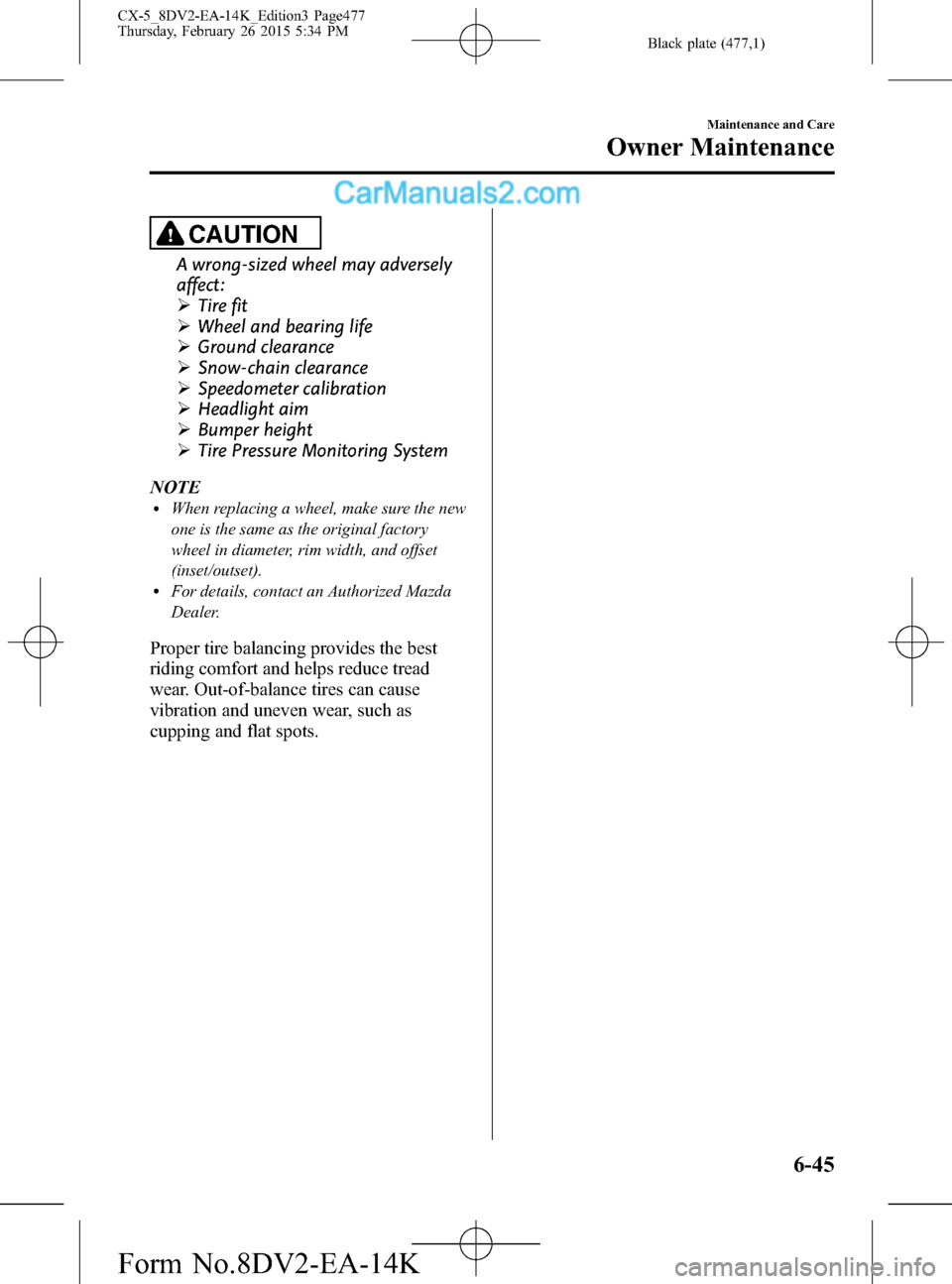
Black plate (477,1)
CAUTION
A wrong-sized wheel may adversely
affect:
ØTire fit
ØWheel and bearing life
ØGround clearance
ØSnow-chain clearance
ØSpeedometer calibration
ØHeadlight aim
ØBumper height
ØTire Pressure Monitoring System
NOTE
lWhen replacing a wheel, make sure the new
one is the same as the original factory
wheel in diameter, rim width, and offset
(inset/outset).
lFor details, contact an Authorized Mazda
Dealer.
Proper tire balancing provides the best
riding comfort and helps reduce tread
wear. Out-of-balance tires can cause
vibration and uneven wear, such as
cupping and flat spots.
Maintenance and Care
Owner Maintenance
6-45
CX-5_8DV2-EA-14K_Edition3 Page477
Thursday, February 26 2015 5:34 PM
Form No.8DV2-EA-14K
Page 567 of 626

Black plate (567,1)
Tire Labeling
Federal law requires tire manufacturers to place standardized information on the sidewall of
all tires. This information identifies and describes the fundamental characteristics of the tire
and also provides a tire identification number for safety standard certification and in case of
a recall.
qInformation on Passenger Vehicle Tires
Please refer to the sample below.
1. TIN: U.S. DOT tire identification number
2. Passenger car tire
3. Nominal width of tire in millimeters
4. Ratio of height to width (aspect ratio)
5. Radial
6. Run-flat tire
7. Rim diameter code
8. Load index & speed symbol
9. Severe snow conditions
10. Tire ply composition and materials used
Customer Information and Reporting Safety Defects
Tire Information (U.S.A.)
8-25
CX-5_8DV2-EA-14K_Edition3 Page567
Thursday, February 26 2015 5:35 PM
Form No.8DV2-EA-14K
Page 568 of 626
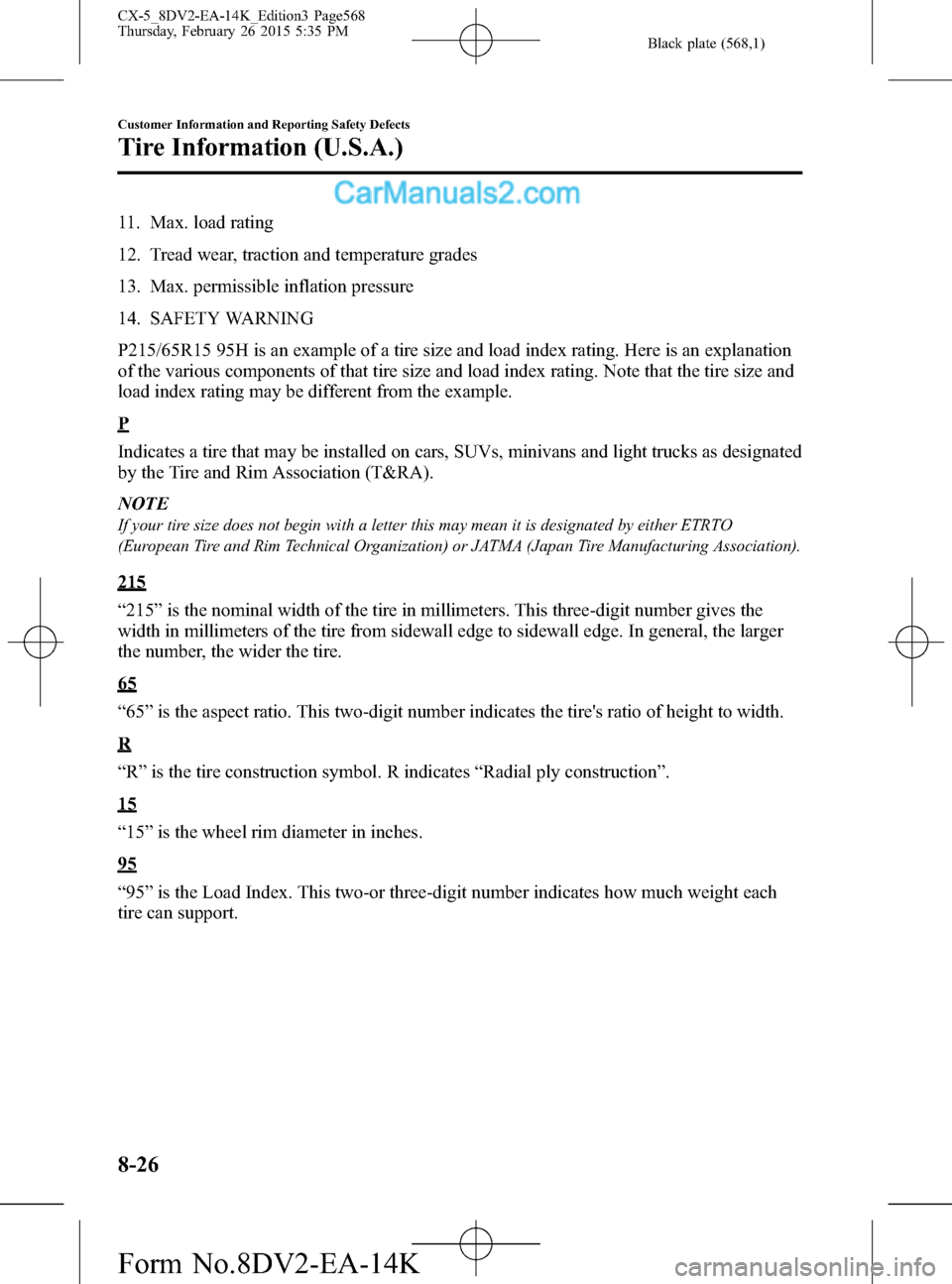
Black plate (568,1)
11. Max. load rating
12. Tread wear, traction and temperature grades
13. Max. permissible inflation pressure
14. SAFETY WARNING
P215/65R15 95H is an example of a tire size and load index rating. Here is an explanation
of the various components of that tire size and load index rating. Note that the tire size and
load index rating may be different from the example.
P
Indicates a tire that may be installed on cars, SUVs, minivans and light trucks as designated
by the Tire and Rim Association (T&RA).
NOTE
If your tire size does not begin with a letter this may mean it is designated by either ETRTO
(European Tire and Rim Technical Organization) or JATMA (Japan Tire Manufacturing Association).
215
“215”is the nominal width of the tire in millimeters. This three-digit number gives the
width in millimeters of the tire from sidewall edge to sidewall edge. In general, the larger
the number, the wider the tire.
65
“65”is the aspect ratio. This two-digit number indicates the tire's ratio of height to width.
R
“R”is the tire construction symbol. R indicates“Radial ply construction”.
15
“15”is the wheel rim diameter in inches.
95
“95”is the Load Index. This two-or three-digit number indicates how much weight each
tire can support.
8-26
Customer Information and Reporting Safety Defects
Tire Information (U.S.A.)
CX-5_8DV2-EA-14K_Edition3 Page568
Thursday, February 26 2015 5:35 PM
Form No.8DV2-EA-14K
Page 571 of 626
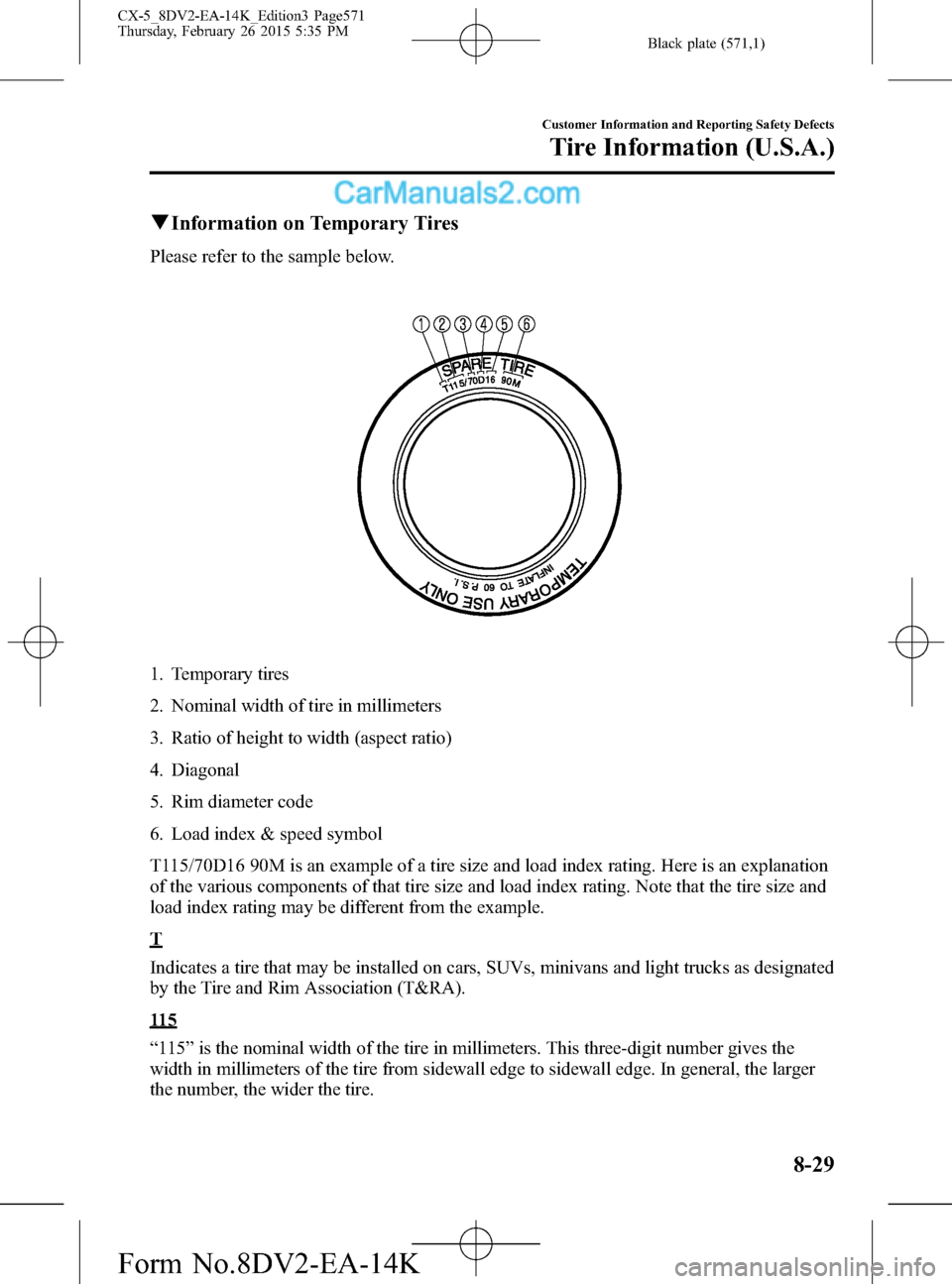
Black plate (571,1)
qInformation on Temporary Tires
Please refer to the sample below.
1. Temporary tires
2. Nominal width of tire in millimeters
3. Ratio of height to width (aspect ratio)
4. Diagonal
5. Rim diameter code
6. Load index & speed symbol
T115/70D16 90M is an example of a tire size and load index rating. Here is an explanation
of the various components of that tire size and load index rating. Note that the tire size and
load index rating may be different from the example.
T
Indicates a tire that may be installed on cars, SUVs, minivans and light trucks as designated
by the Tire and Rim Association (T&RA).
11 5
“115”is the nominal width of the tire in millimeters. This three-digit number gives the
width in millimeters of the tire from sidewall edge to sidewall edge. In general, the larger
the number, the wider the tire.
Customer Information and Reporting Safety Defects
Tire Information (U.S.A.)
8-29
CX-5_8DV2-EA-14K_Edition3 Page571
Thursday, February 26 2015 5:35 PM
Form No.8DV2-EA-14K
Page 572 of 626
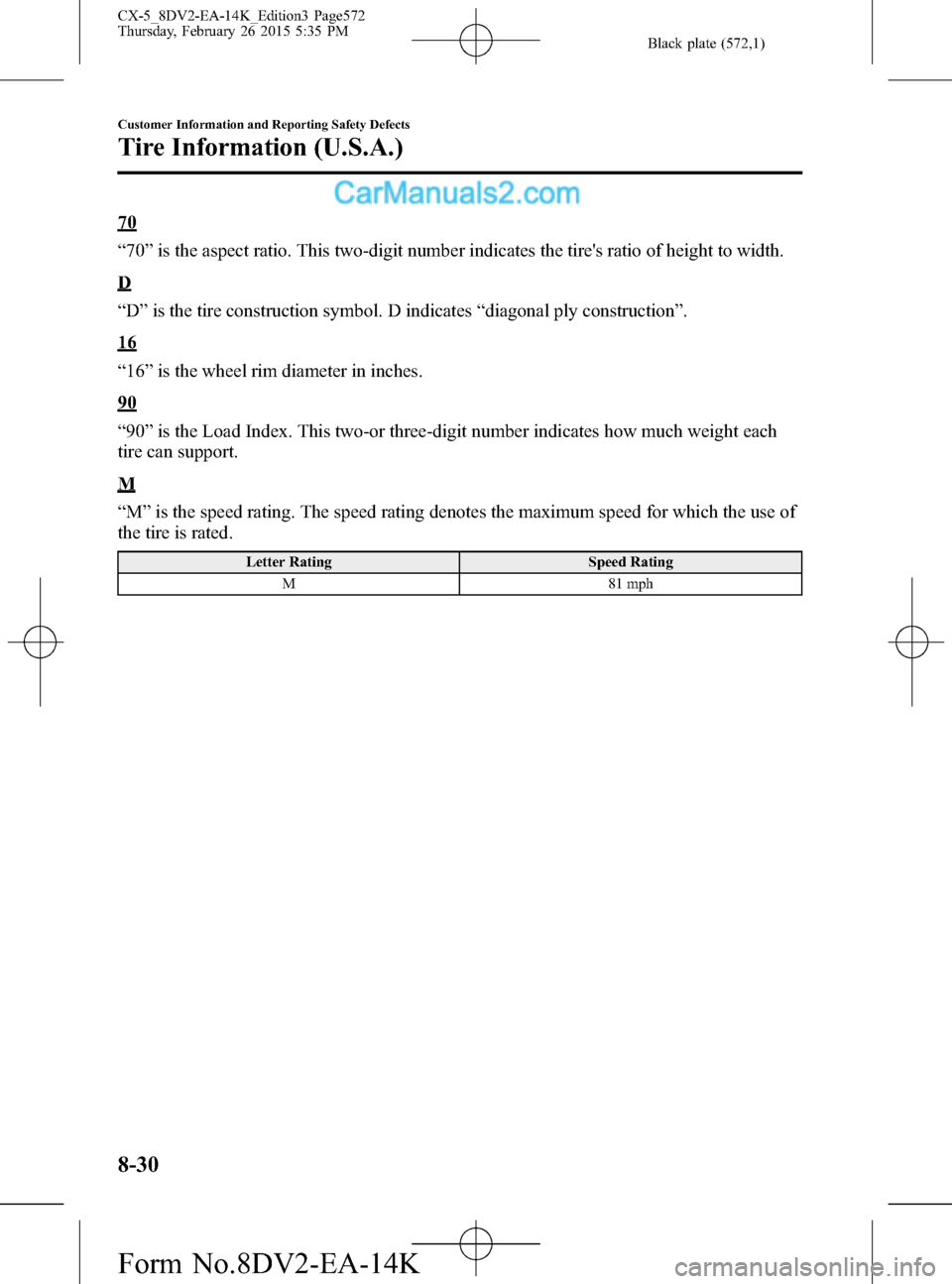
Black plate (572,1)
70
“70”is the aspect ratio. This two-digit number indicates the tire's ratio of height to width.
D
“D”is the tire construction symbol. D indicates“diagonal ply construction”.
16
“16”is the wheel rim diameter in inches.
90
“90”is the Load Index. This two-or three-digit number indicates how much weight each
tire can support.
M
“M”is the speed rating. The speed rating denotes the maximum speed for which the use of
the tire is rated.
Letter Rating Speed Rating
M 81 mph
8-30
Customer Information and Reporting Safety Defects
Tire Information (U.S.A.)
CX-5_8DV2-EA-14K_Edition3 Page572
Thursday, February 26 2015 5:35 PM
Form No.8DV2-EA-14K